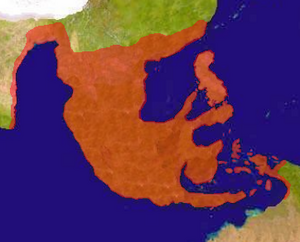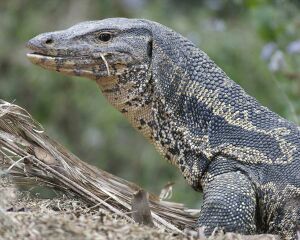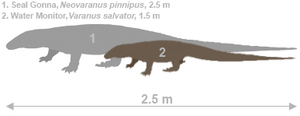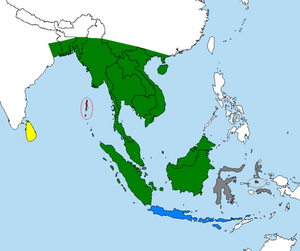Seal Goanna
From Saecula Novae
| Seal Goanna | |
|---|---|
| Scientific classification | |
| Kingdom: | Animalia |
| Phylum: | Chordata |
| Class: | Reptilia |
| Order: | Squamata |
| Family: | Varanidae |
| Genus: | Neovaranus |
| Species: | N. pinnipus |
| Binomial name | |
| Neovaranus pinnipus | |

| |
| Natural range | |
Because most marine mammals went extinct across the southern hemisphere, the niche was once again filled by the reptiles, specifically goannas (Australian monitor lizards) and sea snakes (as snarks and sharkents). Seal goannas (Neovaranus pinnipus) are future goannas that live much like seals do today. They can leave the water at leisure but prefer to live in shallow water, where the young are vulnerable to attacks from sharks. It lives approximately five to ten million years in the future. Since its range streches up to the southern northern hemisphere, it competes with various marine mammalian predators across it's range.
Description
Seal goannas are about two to three metres long with the dominant males being larger (a result of hormone cascades triggered by assuming a dominant position in social hierarchy; former dominant males actually shrink slightly as another hormone cascade kicks in to make them seem less of a threat). Young babies have a bright colouration but the adults have a more greyish colour, lighter underneath.
Seal goannas have a few differences from modern monitor lizards, mostly notably their heavily webbed feet and unusually sturdy claws. The webbing of the foot is best compared to that of the giant otter's--it fully extends from the tip of the toe to the foot itself.
Behavior
Male seal goannas have a threat display that they use against opposing males. On land they first bare their teeth, which are long, curved and serrated - similar to a small steak knife. If this doesn't work then they will emit a loud shrieking sound that can be heard for kilometres. If this still doesn't work then they will fight, often to the death.
Seal goannas live in groups (called lounges) of about seven, organized around an alpha male that is the only breeder. When juvenile seal goannas mature, they will either disperse, stay as a non-breeder, or attempt to replace the alpha male. Usually these groups will rest on rocky outcroppings that the goannas climb onto. Juveniles are better climbers than adults, and often use their climbing abilities to escape adults that would try and eat them. However, the amount of offspring eaten by other monitors is substantially lesser than those of its ancestors, the water monitor.
Evolution
Seal goannas evolved from Varanus salvator, the water monitor. During our time, the water monitor is actually only semi-aquatic, primarily living in swamps and rivers, but it has been known to cross large bodies of water, explaining its wide range (see range map), and has been seen far out to sea. As sea levels increased due to global warming, the water monitor was forced to be more and more aquatic. Meanwhile, the extinction of pinnipeds allowed the water monitor to exploit the niche they had taken.
Seal goannas adopted pinniped social structures (to an extent) for the purpose of mutual protection. Over time, their ancestors gradually evolved paternal care on the part of the mother, and adult females would join together for the purpose of guarding their young against threats. Males, which were up to twice as large as females, would pose a threat. Therefore, it became a strategy for a single adult male to breed with a group of females and protect them from other males--ensuring the survival of his offspring (and the passage of his genes).




